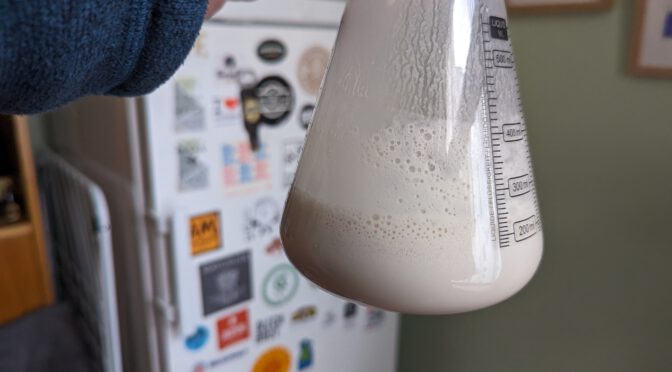The rising costs of ingredients is not just something professional brewers are struggling with, homebrewers also notice the price increases. And ironically, the ingredient that is the smallest by weight is often the most expensive one: yeast.
When I started homebrewing over 10 years ago, dry yeasts were still considered kind of inferior, with a relatively small choice in yeast strains compared to nowadays, they were thought of as sub-standards products because cold chains weren’t considered as crucial as with liquid yeast, and there was a general association with “that homebrew flavour”, probably also because of improper storage.
Liquid yeast on the other hand was thought to be the gold standard, with a large variety in strains, all with their own unique, interesting flavours and aromas that would give homebrewers a key ingredient to push their beer from lackluster to amazing.
It’s March 2024, and I spent €11.49 on a pack of liquid yeast, allegedly the Pilsner Urquell “D” strain, for which I had to create a starter using malt extract to multiply its cell count and improve its vitality. What really happened though was that the yeast was dead, completely dead, and I only noticed it when the starter did not elicit any fermentation activity whatsoever after more than 24 hours on the stir plate.
Instead, I had to resort to my backup plan and rehydrated and pitched two sachets of W-34/70, probably the most widespread bottom-fermenting yeast strain these days. Full disclosure: I got these two sachets for free from a friend who in turn had gotten them at BrauBeviale last December, but if I had had to buy it myself, it would have cost me €9.98. Not much cheaper, but a lot less hassle, because that W-34/70 was rehydrated and noticeably very active in less than 40 minutes, and after pitching it got past the lag phase in something like 24 to 32 hours (no signs of CO2 production at 24 hours, but happily burping away at 32 hours after the pitch).
Now why do I even bother? In the last 5 years of homebrewing, I’ve been mostly brewing bottom-fermented beers, I tried out a number of dry yeast strains, and they were good, with maybe one exception that I found a bit too fruity (and that is a common criticism). Thinking back about all the different bottom-fermenting liquid yeast strains that I used, there was only one that really stood out, and that was Wyeast 2001 (allegedly the Pilsner Urquell “H” strain) due to its very prominent diacetyl note (perfect for a Pilsner Urquell clone). All the others produced beers where the yeast character was just a standard neutral, bottom-fermented flavour, i.e. not much at all.
Every time I picked a specific yeast strain, I chose it for some expected specific flavour element, or “authenticity”, because clearly, a Czech style requires a Czech yeast strain, no? Really, actually, no. One thing I learned in the last few years was that there is so little difference in the yeast strains, you just won’t taste the difference. My Czech Dark Lager, probably the best beer I ever brewed, was fermented with harvested yeast from a German industrial brewery in its 2022 version, and with Fermentis S-189 in its 2023 version, both of them decidedly not Czech yeast strains, and yet both batches tasted exactly like a Czech beer.
So why should I bother about liquid yeast? I probably shouldn’t. The dry yeast strains I’ve had the most success with were Fermentis W-34/70 (a yeast strain is basically an industry standard in its own right, given how ubiquitous it is), Fermentis S-189 (I couldn’t even describe the differences of it to W-34/70, because they absolutely miniscule), and LalBrew Diamond (again, very similar to the others). Fermentis S-23 is also popular, but I found it a bit too fruity, so not exactly my favourite.
With that many similarities, it all boils down to personal preference and maybe price. At my homebrew store of choice, an 11g sachet of LalBrew Diamond costs €4.14, while 11.5g sachets of Fermentis S-189, W-34/70 and S-23 are sold for €4.83, 4.99 and €4.49, respectively. In my experience, two sachets are usually enough for a 20 liter batch of normal-strength beer.
After the frustrating experience with liquid yeast last weekend, I decided for myself that I simply won’t bother with it anymore. Should I ever have the urge of using a pack of liquid yeast, you will definitely hear about it here.

